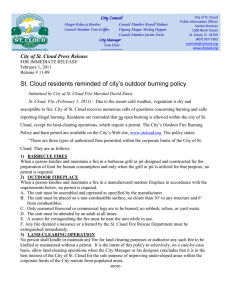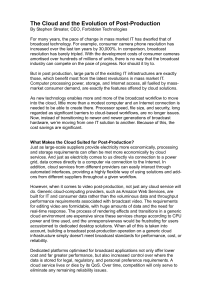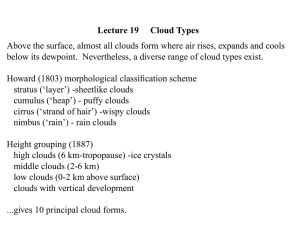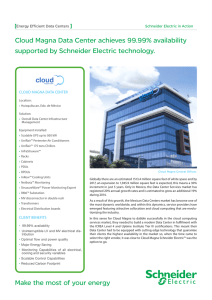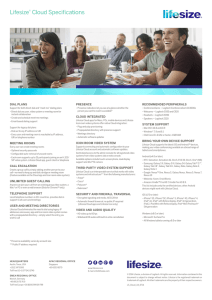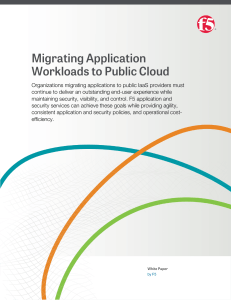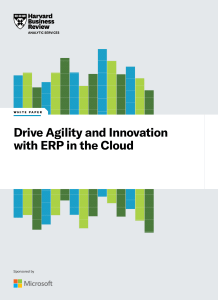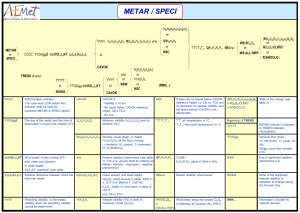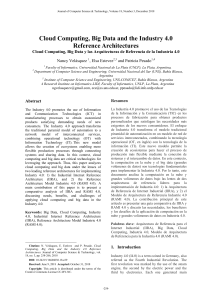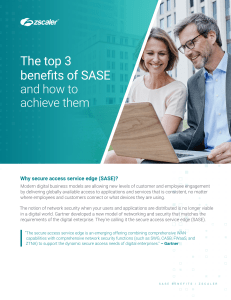La computación en nube Implicaciones para A dit í S id d Auditoría y
Anuncio
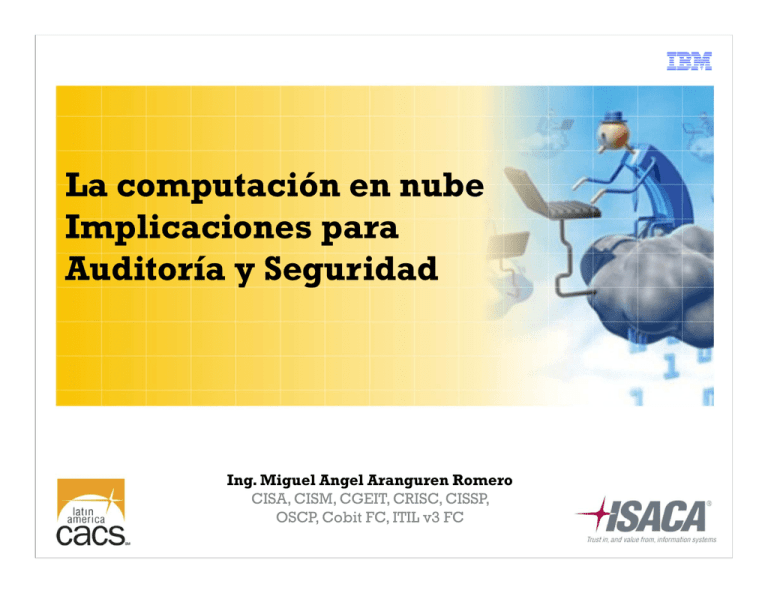
La computación en nube Implicaciones para A dit í y S Auditoría Seguridad id d Ing. Miguel Angel Aranguren Romero CISA, CISM, CGEIT, CRISC, CISSP, OSCP, Cobit FC, ITIL v3 FC Introducción A smarter planet creates new opportunities, but also new risks. The planet is becoming more instrumented, interconnected and intelligent. New possibilities “We have seen more change in the last 10 years than in the previous 90.” New complexities New risks New risks Critical infrastructure protection Ad J. Scheepbouwer, CEO, KPN Telecom Privacy and identity New and emerging threats Cloud security “De las cinco tecnologías evaluadas, las redes sociales, las plataformas móviles y la computación en nube presentan las mayores preocupaciones de riesgos” 64% Herramientas de redes sociales Plataformas móviles 21% 15% 54% . 27% 19% 42% Computación en nube Fabricación, América del Norte 35% 24% 26% 31% Virtualización 43% Arquitectura orientada a servicios a servicios Extremadamente riesgoso / riesgoso “Estamos preocupados por tener capacidad para controlar de manera segura el flujo de datos hacia y desde los dispositivos móviles de los empleados y de almacenarlos con seguridad” almacenarlos con seguridad 25% 42% 34% Algo riesgoso Moderadamente riesgoso / sin ningún riesgo Fuentes: The Economist Intelligence Unit and IBM Institute for Business Value (556 encuestados). Q17 (¿Cuán grande es el riesgo de las siguientes tecnologías y herramientas para su empresa?) “Ya estamos examinando la computación en nube y aún no se ha perfeccionado la seguridad en nuestras propias redes locales.” Asistencia Medica, América del Norte Regardless of the model ‐ public, private or hybrid – security remains the top concern for cloud adoption.1 80 percent p of enterprises consider security the number one inhibitor to cloud adoptions 48 percent of enterprises are concerned about the reliability of clouds 33 percent of respondents are concerned with cloud interfering with their ability to comply interfering with their ability to comply with regulations 1Driving Profitable “How can we be assured that our data will not be leaked and that the vendors have the technology and the governance to control its employees from stealing data?” “Security is the biggest concern. I don’t worry much about the other “‐ities” – reliability, availability, etc.” “I prefer internal cloud to IaaS1. When the service is kept internally, I am more comfortable with the security that it offers ” security that it offers.” Growth Through Cloud Computing, IBM Study (conducted by Oliver Wyman), March, 2010 Terminología g Cloud defined: a consumption and delivery model optimized by workload. • “Cloud” is an emerging style of computing that uses consumption computing that uses consumption and delivery models to provide applications, data and IT resources as services to users over the network the network • Cloud allows: – Self‐service – Sourcing options – Flexible payment models – Economies‐of‐scale Cloud is: An infrastructure and management methodology A business model A user A user experience • Cloud represents: – The industrialization of delivery for The industrialization of delivery for IT‐supported services Cloud lets you manage large numbers of highly virtualized resources that resemble a single large resource which can be used to deliver services. Cloud computing delivery models include private, hybrid and public. Private: Access limited to enterprise and its partner network Dedicated resources Single tenant Single tenant Drives efficiency, standardization and best practices while retaining greater customization and t t i ti d control Might be managed or hosted by third party Cloud services i Cloud computing model d l Hybrid: Private infrastructure, integrated with public cloud Public: Open access, subject to subscription Shared resources Multiple tenants Delivers select set of Delivers select set of standardized business process, application or infrastructure services on a flexible price per use a flexible price‐per‐use basis Always managed and hosted by a third party Standardization, capital preservation, flexibility and time to deploy … Customization, efficiency, availability, resiliency, security and privacy … Las bondades de la computación en nube Las bondades de la computación en nube Enterprises are benefitting from cloud computing in tangible and significant ways. Results from cloud computing engagements From: To: Test provisioning Test provisioning Weeks Minutes Change management Months Days or hours Release management Weeks Minutes Administered Self service Standardization Complex p Reuse and share Metering and billing Fixed cost Variable cost Server and storage utilization tili ti 10 to 20 percentt 70 to 90 percent p Years Months Increased speed Increased speed and flexibility1 Service access Reduced costs1 Reduced costs Payback period 1Based on IBM and client‐engagement experience The View of Cloud Computing ““Cloud” is a l d” new consumption and delivery model dd l d l inspired by consumer db Internet services. Cloud is enabled by: Pooling and virtualization of resources Automation of service management Standardization of workloads Cloud enables: Self‐service Location independence L ti i d d Flexible payment models Economies‐of‐scale Cloud represents: The industrialization of delivery for IT supported services pp Cloud Services Software Hardware Storage Networking Las dificultades de implementación Las dificultades de implementación Control Many companies and governments Many companies and governments are uncomfortable with the idea of their information located on systems they do not control. Providers must offer a high degree of security transparency to help put customers at transparency to help put customers at ease. Compliance Complying with SOX1, HIPAA2 and other regulations may prohibit the use g yp of clouds for some applications. Comprehensive auditing capabilities are essential. Reliability Data Migrating workloads to a shared Migrating workloads to a shared network and compute infrastructure increases the potential for unauthorized exposure. Authentication and access technologies become increasingly important. High availability will be a key concern. IT departments will worry about a loss of service should outages occur. Mission critical applications may not run in the cloud without strong availability guarantees. il bilit t Management Providers must supply easy controls to manage firewall and security settings for applications and runtime environments in the cloud. One‐size does not fit‐all: Different cloud workloads have unique risk profiles. High Need for security aassurance Mission‐critical workloads, personal information Analysis and simulation with public data Low Mid‐risk Business risk Business risk Quality of protection adapted to risk Direct visibility and control Significant level of assurance Today’s clouds are primarily here: Lower‐risk workloads One‐size‐fits‐all approach to data protection No significant assurance Price is key Training and testing with non‐sensitive data Low‐risk Tomorrow’s high‐value and high‐risk workloads need: High‐risk Perspectiva de auditoría y seguridad I li Implicaciones i y recomendaciones d i Preparing to Move to the Cloud “Cloud Computing” is complex where to begin: is complex where to begin: Cloud Computing Establish a set of objectives that clarify what a successful engagement in the cloud would look like. If externally hosting your cloud ensure that your vendor is reliable Identify what workloads you are most comfortable Identify what workloads you are most comfortable with don’t just dive in. Determine the appropriate security for your workload, and leverage managed services where workload, and leverage managed services where possible Multiple Delivery Models and Security Impacts Delivery Models provide context into who is responsible for each clouds security Governance Jurisdiction and regulatory requirements • Can data be accessed and stored at rest within regulatory constraints? • Are development test and operational clouds managing data within the required • Are development, test and operational clouds managing data within the required jurisdictions including backups? Complying with Export/Import controls • Applying encryption software to data in the cloud, are these controls permitted in a particular country/jurisdiction? l / • Can you legally operate with the security mechanisms being applied? Compliance of the infrastructure •• Are you buying into a cloud architecture/infrastructure/ service which is not Are you buying into a cloud architecture/infrastructure/ service which is not compliant? Audit and reporting • Can you provide the required evidence and reports to show compliance to regulations such as PCI and SOX? regulations such as PCI and SOX? • Can you satisfy legal requirements for information when operating in the cloud? Data Data location and segregation • Where does the data reside? How do you know? h d h d d ? d k ? • What happens when investigations require access to servers and possibly other people’s data? Data footprints • How do you ensure that the data is where you need it when you need it, yet not left behind? • How is it deleted? • Can the application code be exposed in the cloud? Backup and recovery • How can you retrieve data when you need it? • Can you ensure that the backup is maintained securely, in geographically separated locations? Administration • How can you control the increased access administrators have working in a virtualized model? • Can privileged access be appropriately controlled in cloud environments? p g pp p y Architecture Protection • How do you protect against attack when you have a standard infrastructure and the same vulnerability exists in many places across that infrastructure? Hypervisor vulnerabilities Hypervisor vulnerabilities • How can you protect the hypervisor (a key component for cloud infrastructures) which interacts and manages multiple environments in the cloud? The hypervisor being a potential target to gain access to more systems, and hosted images. M lti t Multi‐tenant environments t i t • How do you ensure that systems and applications are appropriately and sufficiently isolated and protecting against malicious server to server communication? Security policies Security policies • How do you ensure that security policies are accurately and fully implemented across the cloud architectures you are using and buying into? Identity Management y g • How do you control passwords and access tokens in the cloud? • How do you federate identity in the cloud? • How can you prevent user IDs/passwords being passed and exposed in the cloud unnecessarily increasing risk? unnecessarily, increasing risk? “67% of all web application vulnerabilities had no patch in 2009.” Source: IBM Security Solutions X‐Force 2009 Source: IBM Security Solutions X Force 2009 Trend and Risk Report, published Feb 2010. Applications Software Vulnerabilities • How do you check and manage vulnerabilities in applications? • How do you secure applications in the cloud that are increasing targets due to the large user y pp g g g population? Patch management • How do you secure applications where patches are not available? y pp p • How do you ensure images are patched and up to date when deployed in the cloud? Application devices • How do you manage the new access devices using their own new application software? How do you manage the new access devices using their own new application software? • How do you ensure they are not introducing a new set of vulnerabilities and ways to exploit your data? Assurance Operational oversight •• When logs no longer just cover your own environment do you need to retrieve and analyse When logs no longer just cover your own environment do you need to retrieve and analyse audit logs from audit logs from diverse systems potentially containing information with multiple customers? Audit and assurance • What level of assurance and how many providers will you need to deal with? What level of assurance and how many providers will you need to deal with? • Do you need to have an audit of every cloud service provider? Investigating an incident • How much experience does your provider have of audit and investigation in a shared environment? p y p g • How much experience do they have of conducting investigations without impacting service or data confidentiality? Experience of new cloud providers • What will the security of data be if the cloud providers are no longer in business? • Has business continuity been considered for this eventuality? Mejores Prácticas Propuesta p Metodológica g Iniciando 1. Define a cloud strategy with security in mind gy y Identify the different workloads and how they need to interact. Which models are appropriate based on their security and trust requirements and the systems they need to interface to? 2. Identify the security measures needed Using a framework Security, allows teams to capture the measures that are needed in areas such as governance, architecture, g , , applications and assurance. 3. Enabling security for the cloud. The upfront set of assurance measures you will want to take. Assessing The upfront set of assurance measures you will want to take Assessing that the applications, infrastructure and other elements meet your security requirements, as well as operational security measures. Propuesta Metodológica 1. Implement and maintain a security program. 2. Build and maintain a secure cloud infrastructure. 3. Ensure confidential data protection. 4. Implement strong access and identity management. 5 Establish application and environment provisioning. 5. Establish application and environment provisioning 6. Implement a governance and audit management program. 7. Implement a vulnerability and intrusion management program. 8. Maintain environment testing and validation. Conclusiones y Reflexiones finales Conclusiones y reflexiones finales Cloud computing offers new possibilities and new challenges. Cl d ti ff ibiliti d h ll These challenges range from governance, through to securing application and infrastructure. Fundamentally it is important to be able to assure the security of these new models in order to build trust and confidence. The key to establishing trust in these new models is choosing the right cloud computing model for your organization. Place the right workloads in the right model with the right security mechanisms. •For those planning to consume cloud services looking for trust and assurance from the cloud provider; understanding the service level agreements and the approaches to security is key. Assessing that this can be delivered, including what assurances can be provided will be important. • For those providing or building a cloud infrastructure, using a proven methodology and technologies that can deliver appropriate security is key. This is not just a technical challenge but a challenge of governance and compliance; applications and infrastructure; and assurance. GRACIAS!!! Ing. Miguel Angel Aranguren Ing Miguel Angel Aranguren Romero CISA, CISM, CGEIT, CRISC Cobit Foundations Certificate CISSP, OSCP ITIL v3 Foundations Certificate [email protected] Miguel aranguren@gmail com [email protected] [email protected]
